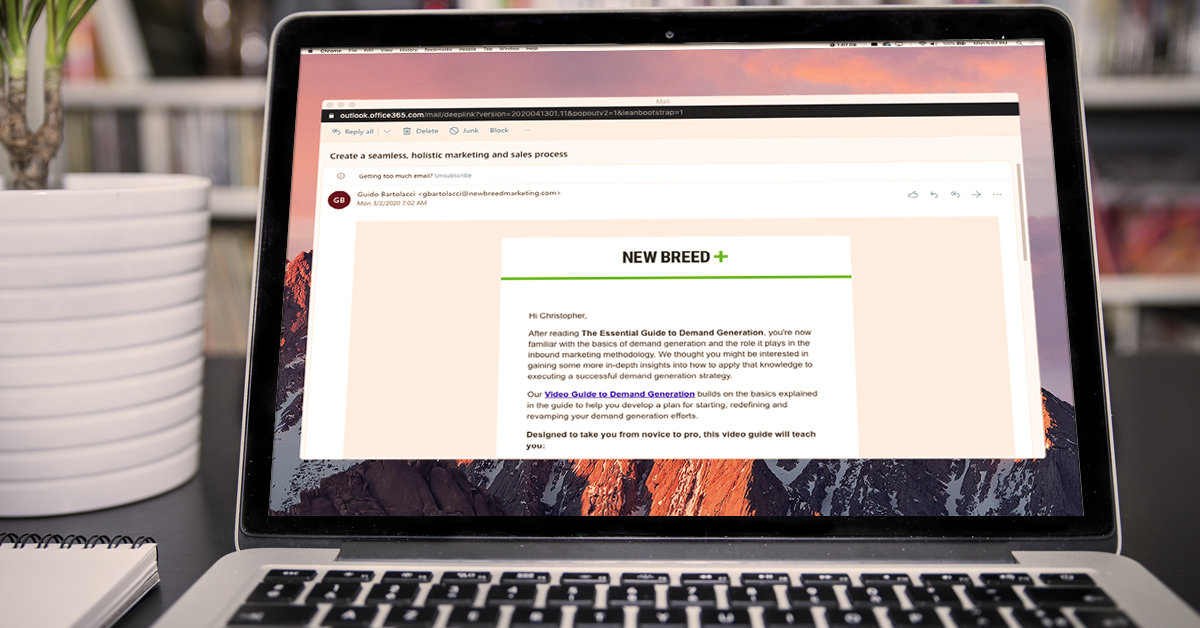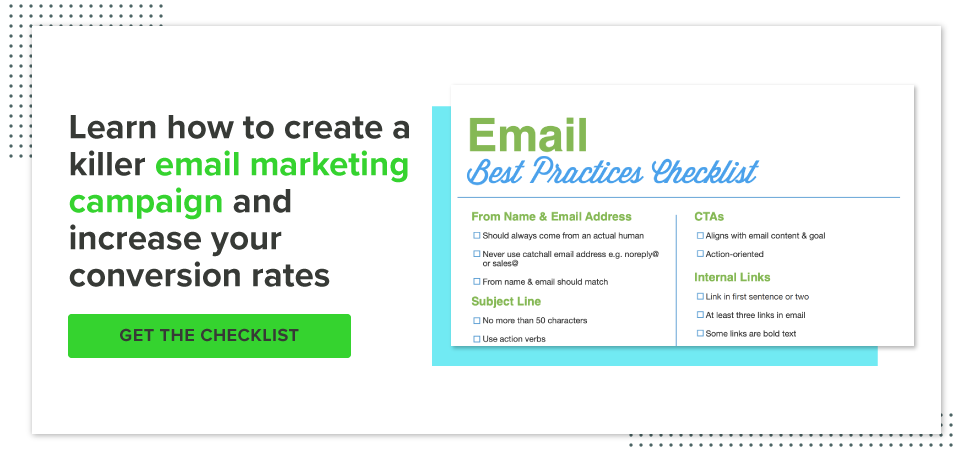Sales vs. Marketing Email Best Practices

Marketing and sales emails are fundamentally different, but when done incorrectly they can both damage your perception of a company.
Whether the messages you receive feel irrelevant or just appear in your inbox too frequently, it’s all too easy to delete them on sight, unsubscribe or mark them as spam.
But as a marketer or sales rep, you don’t want your emails getting deleted while unread. You sent that message for a reason, so how do you increase the chances of the recipient reading it and taking your desired action?
The first step is understanding what you’re trying to accomplish with your emails.
The Goals of Marketing and Sales Emails
Every successful marketing campaign starts with a goal, and when it comes to marketing and sales emails, the goals are drastically different.
“With marketing, the ultimate goal is to get a conversation started with sales,” says Guido Bartolacci, New Breed’s Head of Demand Generation. “There’s a few pieces of information you need to know ahead of time in order to do that.”
In order for a sales rep to have a valuable conversation with a prospect, they need information on who that person is and how they can be helped by your product or service.
“Part one of marketing follow-up is to send people content that is relevant to them so they continue to stay engaged,” Guido says. “But as you do that, you need to continue collecting information on them to identify their persona, learn more about their company and understand their challenges. That way you can send marketing emails that are contextually-relevant and pass along what you’ve learned to the sales team so that they can start a valuable conversation.”
To collect that information, your marketing emails should promote gated content related to the interests a prospect has expressed. When they access that content, they provide you with their information through forms. As your communications progress, the content you send should guide them through the buyer’s journey so as you learn more about the prospect they become more sales-ready.
Once prospects are handed off to the sales team, marketing’s job doesn’t stop, but it does shift to be primarily focused on trust-building.
The overall goal of sales emails is to book a meeting, but that does not mean booking a meeting is the goal of every individual email. Understanding where the prospect is in the decision-making process will help you understand what’s the most appropriate ask for each email.
Every sales email should have a “give” and a “get.” A give is the value you provide in the form of a resource, insights about their company or information about their industry. A get is what you’re asking the recipient to do for you. You can have multiple gives in an email, but you should only have one get.
“When you give them multiple options or ask for multiple things, that’s when people get overwhelmed and choose none,” says Inside Sales Manager Beth Abbott.
If a prospect is not quite ready to book a meeting with you, your get can be the confirmation of information collected during the marketing process. It’s better to build up some rapport first and then ask for a meeting a couple emails in, depending on their engagement.
While sales is conducting their email outreach, a prospect may still be receiving marketing emails — and that’s totally acceptable as long as the teams are aligned on how their messages are working in harmony. As sales is pursuing their goal of booking a meeting, marketing emails can assist them by building trust with case studies and testimonials. However, for the two communication types to be working toward their goal, they need to be coordinated in a way that doesn’t overwhelm the prospect.
Personalizing Your Emails
“One of the things that always jumps out at me as the biggest difference between sales and marketing emails is that marketers have to master one-to-many messaging and sales reps need to master one-to-one, which just inherently comes off as a different tone,” Beth says.
While sending marketing emails from a generic marketing@companydomain email address used to be the norm, the industry has shifted so now most, if not all, emails should come from a person. This helps humanize your communications and also increases your likelihood of catching direct responses if recipients choose to reply.
“There are different styles, and everyone has different styles that work for them. Some of it will actually be dictated by the person who is sending those emails out and what their personality is like,” Guido says. “There’s some companies where they have big banners and every email is really heavily designed. Then there’s the other end of the spectrum where you have people like Dave Gerhardt or Neil Patel whose emails sound like they’re coming directly from them. It’s short punchy content.
“And then there’s stuff in between, where it’s not necessarily boilerplate, but you have ‘intro paragraph, subheading, bullet points, call-to-action,’” Guido continues. “Each of those approaches can be successful. It really comes down to the team and the skillsets you have and what your audience will be most receptive to.”
Regardless of your style, you should still try to add some level of personalization into your marketing emails. This is typically done through the use of personalization tokens or smart content in your marketing automation platform.
By using these features, you can call a recipient by name or include a detail you know about them, but the overall email remains about the same for everyone who gets it.
On the other hand, sales emails might follow frameworks or “templates” but the text itself should be hyper-specific to the company.
“I think there are opportunities for sales reps to be more efficient with some of their outreach by having some type of bare-bones templates that they’re using just to fill in some of the really common things we say, but ultimately I think sales emails are most impactful when they’re customized,” Beth says.
Our team has seen more success with a few high-quality customized emails than pushing out a large quantity of templated messages.
“I would much rather see reps take their time on those emails rather than being super automated, even if that means they send out 50 emails a day instead of 300. They’ll get twice as many people to respond from those personalized messages,” Beth says.
How a sales email gets personalized depends on the source of the lead.
“If it’s an inbound lead, the way we’re customizing it is by understanding their digital body language. What did they download and what can that imply their greatest challenge is right now? That coupled with initial research on their company and their role to see what they’re responsible for so that first customized touchpoint is actually based on our perception of what their situation is right now,” Beth says
Outbound leads require more research into commonalities between the sales rep and the lead. Since that prospect isn’t familiar with your company already, they have to build trust person-to-person. Reps can do this by looking for shared connections, nearby hometowns or common interests.
Trigger events, changes that have occurred in a prospect’s life, can also provide a great starting point for a sales email.
“Through your research of that company and that person, is there something of note that’s worthwhile pointing out? Did they just get a new job or promotion? Did their company just get a lot of funding or win a big award?” Beth prompts.
Weaving these types of triggers into initial outreach helps to break the ice and proves that you’ve actually spent some time looking into the prospect before writing them an email.
How Frequently to Send Emails
Regardless of if you’re sending marketing or sales communications, the best practices for email cadences vary based on the behavior of the prospect.
“I would say generally you don’t want to email someone more than 2–3 times per week,” Guido says about marketing emails.
But you can email more frequently if someone’s engagement warrants it.
“If someone’s opening, clicking, downloading something from every email that you send them, you can keep going. There’s no reason to use three per week as a cap. I would say until you see that engagement, I wouldn’t exceed that though,” Guido says.
For sales, cadence will depend on the lead type.
“When they’re outbound or they’re colder leads, you want to make sure you space your emails out a little bit more to assess your timing,” Beth says.
But even for inbound leads, you don’t want to be locked into a predetermined cadence. Instead, try to be reactive to how each prospect engages with your outreach.
For example, say you send out first touch emails to 20 prospects on Monday and 10 people opened it but didn’t respond and the other 10 prospects didn’t open it. You won’t want to send a follow-up email on Tuesday to the prospects who haven’t opened the email yet. But, you can consider sending a Tuesday follow-up to the prospects who did interact with your email.
But whether or not a next-day follow-up is appropriate also depends on what the ask is from your original email. If your first touch was providing a resource, you need to give prospects time to take in the information you provided.
“There’s no one playbook that’s going to work really well,” Beth says. “If you really box yourself in to using specific cadences for certain situations, you’re not going to be as successful as if you can be really reactive with how you’re reaching out to people in certain groups depending on their engagement.”
The Takeaway
Even though marketing emails are one-to-many and sales emails are one-to-one, both teams can learn a lot from each other.
While the tone, style and goal of marketing and sales emails differ, there are a lot of best practices that are the same, like having only one call-to-action per email.
If both teams work together and learn from what’s been working for other team members, email outreach can become more successful company-wide.
Quinn Kanner
Quinn is a writer and copyeditor whose work ranges from journalism to travel writing to inbound marketing content.





